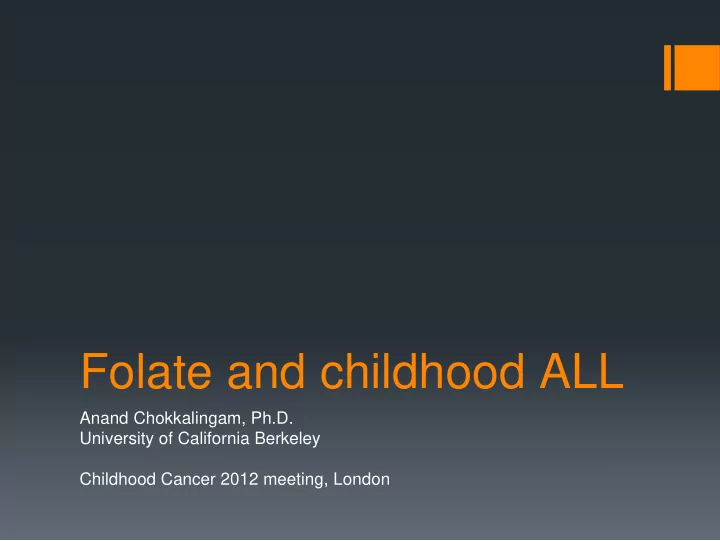

Folate and childhood ALL Anand Chokkalingam, Ph.D. University of California Berkeley Childhood Cancer 2012 meeting, London
Background � Childhood ALL: biologically heterogeneous disease characterized by chromosomal breakage and abnormalities. � Folate deficiency has been associated with chromosomal breakage and abnormalities, and is a potential causal agent in childhood ALL � Epidemiologic studies of maternal folate intake during pregnancy (diet and supplements) have been mixed; recent meta-analysis indicates little to no effect of folate supplementation a � A child’s exposure to folate prior to diagnosis is modulated by several factors…. a Milne et al, Int J Cancer, 2010
Potential exposure periods for folate In-utero environment Child's Mother's folate Mother's Child's post-natal Future intake/ folate folate folate ALL risk? supplementation genes genes intake Child’s DBS DBS x genes (Poster 11-4) Child’s diet (Poster 3-10) (Poster 11-5)
NCCLS Northern California Childhood Leukemia Study Population-based case-control study Cases: incident ALL <15 years Controls: matched to cases >40% Hispanic In-person interviews used to elicit information on maternal pre-pregnancy dietary folate intake and supplement use, as well as child’s early diet (prior to age 2) Included subjects were those enrolled 1995- 2002
Child’s Folate Metabolism genes � CBS � Candidate gene approach: � DHFR 72 htSNPs in 10 genes � FOLH1 � Illumina Goldengate � MTHFD1 � Haplotype sliding window � MTHFR analysis � MTR � Sample size: 377 cases, � MTRR 448 controls � SHMT1 � SLC19A1 � TYMS
CBS in Hispanics
CBS Remarks � Overexpression of CBS decreases levels of homocysteine, inducing functional folate deficiency (“folate trap”) � Because homocysteine is at the intersection of the DNA synthesis and repair pathway and the DNA methylation pathway, overexpression of CBS may lead to alteration in these functions � CBS is over-expressed in children with trisomy 21 � Cellular lesions caused by the “folate trap” may relate to leukemia risk in children with Down syndrome. � Future studies should investigate whether specific CBS alleles are overrepresented in the additional chromosome 21 within hyperdiploid leukemias
Potential exposure periods for folate In-utero environment Child's Mother's folate Mother's Child's post-natal Future intake/ folate folate folate ALL risk? supplementation genes genes intake
Neonatal DBS folate Folate (FOL) assays a Study subjects Children with available dried Performed on DBS blood spot (DBS) collected at specimens, normalized for birth by the California Hemoglobin (Hb): Department of Public Health HbFOL (nmol/g) = FOL DBS (nmol/L) / Hb DBS (g/L) (California births only) 2 replicates per DBS Sample size 313 ALL cases, 405 controls a O’Broin SD and Gunter EW. Am J Clin Nutr 1999;70:359-67
Neonatal folate results for ALL In addition to null effects for N Mean (SD) * p total ALL, no associations were 0.941 All birth periods observed after stratifying for: Case 313 2.82 (1.02) Control 405 2.81 (1.02) Pre-pregnancy supplement use 1982-1994 0.977 Hispanic ethnicity Case 147 2.76 (1.03) Control 194 2.76 (1.03) Major ALL subtypes, including overall B-cell ALL, B-cell 1995-1998 0.344 hyperdiploid ALL, and B-cell Case 130 2.95 (1.04) Control 173 2.83 (1.03) ALL with structural abnormalities (translocations, 1999-2002 0.225 Case 36 2.52 (1.08) deletions) Control 38 2.87 (1.07) *HbFOL in nmol/g, adjusted for income, race/ethnicity (H, NHW, NHO), sex, and age; back-transformed from log(HbFOL)
Neonatal folate Remarks Robust assay methodology, large sample size Results do not support an association between blood folate levels at birth and risk of childhood ALL Together with inconsistent findings for maternal folate supplementation and dietary intake, these findings suggest that folate exposures before birth may not play a role in risk of childhood ALL However, our results do not rule out a role for: Folate exposures after birth, or Modification of birth folate effects by other factors, including child’s genetic susceptibility and post-natal exposures
Child’s early diet Previous findings* � Oranges/Bananas: OR regular vs rare =0.49 (0.26-0.94) � Orange juice: OR regular vs rare =0.54 (0.31-0.94) � Other food groups assessed (with no association) � Apples/Grapes � Beef � Hot dogs/Deli meat � Other fruit juice � Soda � Vegetables *Kwan et al, AJE, 2004
Child’s early diet and neonatal folate Test for interaction between neonatal folate levels (tertiles) and food group intake (LR test) Strongest observed interaction was with Oranges/Bananas Reduced risk main effect largely limited to low folate tertile
Child’s early diet and neonatal folate: Remarks � Absence of interaction effect with “vegetable” food group � Variety of vegetables included in this group � Oranges/bananas are high in folate… � Could children with lower folate levels at birth experience a benefit from other sources of folate in early life? � Biologically intriguing, but still an exploratory analysis � requires confirmation and followup
Future directions � Predictors of newborn folate levels, incorporating multiple factors discussed here
Acknowledgements UC Berkeley UCSF � Patricia Buffler � Joseph Wiemels � Helen Hansen � Catherine Metayer � Emily Noonan-Place � Danielle Chun IARC � Lisa Barcellos � Ghislaine Scelo CDC Funding support � Christine Pfeiffer � Children with Cancer UK � Mindy Zhang � NIEHS, NCI
Recommend
More recommend